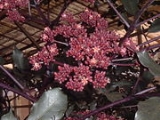
Leea
Encyclopedia
Leea is a genus of plants that are distributed throughout Northern and eastern Australia
, New Guinea
, South and Southeast Asia
and parts of Africa
. Leea contains approximately 70 species and is placed in the Vitaceae
family. The APG II system
places Leea in the subfamily Leeoideae (Vitaceae). Leea is often placed in its own family, Leeaceae, based on morphological differences between it and Vitaceae. These differences include ovule
number per locule
(two in Vitaceae and one in Leeaceae), carpel number (two in Vitaceae and three in Leeaceae), and the absence or presence of a staminoidal tube (present in Leeaceae) and floral disc (present in Vitaceae). Pollen structure has also been examined for taxonomic demarcation, though studies have concluded that the pollen of Leeaceae and Vitaceae suggests the families should remain separate while other studies conclude that Leea should be included in Vitaceae.
The genus was named by Linnaeus
after James Lee, the Scottish nurseryman based in Hammersmith
, London who introduced many new plant discoveries to England at the end of the 18th century.
as a mechanism to prevent self pollination
.
Australia
Australia , officially the Commonwealth of Australia, is a country in the Southern Hemisphere comprising the mainland of the Australian continent, the island of Tasmania, and numerous smaller islands in the Indian and Pacific Oceans. It is the world's sixth-largest country by total area...
, New Guinea
New Guinea
New Guinea is the world's second largest island, after Greenland, covering a land area of 786,000 km2. Located in the southwest Pacific Ocean, it lies geographically to the east of the Malay Archipelago, with which it is sometimes included as part of a greater Indo-Australian Archipelago...
, South and Southeast Asia
Southeast Asia
Southeast Asia, South-East Asia, South East Asia or Southeastern Asia is a subregion of Asia, consisting of the countries that are geographically south of China, east of India, west of New Guinea and north of Australia. The region lies on the intersection of geological plates, with heavy seismic...
and parts of Africa
Africa
Africa is the world's second largest and second most populous continent, after Asia. At about 30.2 million km² including adjacent islands, it covers 6% of the Earth's total surface area and 20.4% of the total land area...
. Leea contains approximately 70 species and is placed in the Vitaceae
Vitaceae
Vitaceae are a family of dicotyledonous flowering plants including the grapevine and Virginia creeper. The family name is derived from the genus Vitis...
family. The APG II system
APG II system
The APG II system of plant classification is the second, now obsolete, version of a modern, mostly molecular-based, system of plant taxonomy that was published in April 2003 by the Angiosperm Phylogeny Group. It was a revision of the first APG system, published in 1998, and was superseded in 2009...
places Leea in the subfamily Leeoideae (Vitaceae). Leea is often placed in its own family, Leeaceae, based on morphological differences between it and Vitaceae. These differences include ovule
Ovule
Ovule means "small egg". In seed plants, the ovule is the structure that gives rise to and contains the female reproductive cells. It consists of three parts: The integument forming its outer layer, the nucellus , and the megaspore-derived female gametophyte in its center...
number per locule
Locule
A locule is a small cavity or compartment within an organ or part of an organism ....
(two in Vitaceae and one in Leeaceae), carpel number (two in Vitaceae and three in Leeaceae), and the absence or presence of a staminoidal tube (present in Leeaceae) and floral disc (present in Vitaceae). Pollen structure has also been examined for taxonomic demarcation, though studies have concluded that the pollen of Leeaceae and Vitaceae suggests the families should remain separate while other studies conclude that Leea should be included in Vitaceae.
The genus was named by Linnaeus
Carolus Linnaeus
Carl Linnaeus , also known after his ennoblement as , was a Swedish botanist, physician, and zoologist, who laid the foundations for the modern scheme of binomial nomenclature. He is known as the father of modern taxonomy, and is also considered one of the fathers of modern ecology...
after James Lee, the Scottish nurseryman based in Hammersmith
Hammersmith
Hammersmith is an urban centre in the London Borough of Hammersmith and Fulham in west London, England, in the United Kingdom, approximately five miles west of Charing Cross on the north bank of the River Thames...
, London who introduced many new plant discoveries to England at the end of the 18th century.
Ecology
Leea flowers are visited by a variety of potential insect pollinators, including flies, wasps, bees, butterflies, and beetles. Some species may have evolved synchronized dichogamyDichogamy
Sequential hermaphroditism is a type of hermaphroditism that occurs in many fish, gastropods and plants. Here, the individual is born one sex and changes sex at some point in their life. They can change from a male to female , or from female to male...
as a mechanism to prevent self pollination
Pollination
Pollination is the process by which pollen is transferred in plants, thereby enabling fertilisation and sexual reproduction. Pollen grains transport the male gametes to where the female gamete are contained within the carpel; in gymnosperms the pollen is directly applied to the ovule itself...
.

